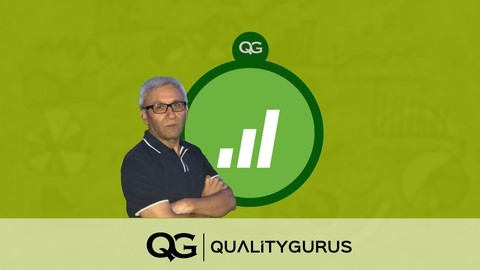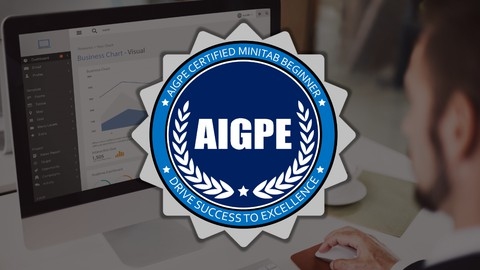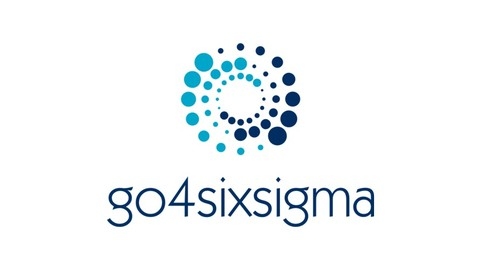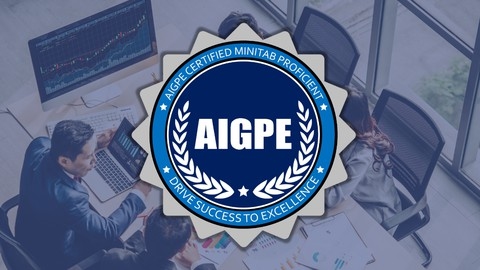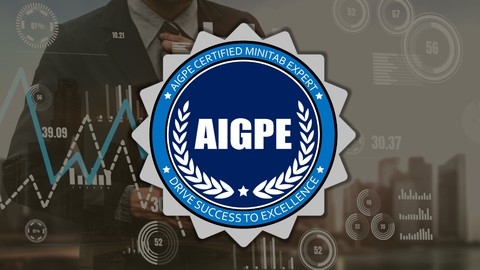Minitab is a powerful statistical software package used by professionals in various fields, including manufacturing, healthcare, and engineering, to analyze data, improve processes, and make data-driven decisions.
Learning Minitab can significantly enhance your analytical skills and open doors to new career opportunities.
By mastering Minitab, you can gain valuable insights from data, identify areas for improvement, and contribute to more efficient and effective processes within your organization.
Finding the right Minitab course on Udemy, however, can be a bit overwhelming.
With so many options available, it’s hard to know which course will provide the comprehensive training and practical experience you need to truly master this versatile software.
You need a course that not only covers the theoretical foundations but also provides hands-on exercises and real-world examples to solidify your understanding.
Based on our in-depth analysis, we’ve identified the Six Sigma: Certified Lean Six Sigma Green Belt (Accredited) course as the best overall Minitab course on Udemy.
This comprehensive program not only teaches you the fundamentals of Minitab but also integrates it within the broader context of Six Sigma methodology.
This approach allows you to learn how to use Minitab to solve real-world problems and drive meaningful improvements within your organization.
The course also includes valuable certification upon completion, boosting your professional credentials.
This is just one of the many excellent Minitab courses available on Udemy.
Whether you’re a beginner looking for a foundational understanding or an experienced professional seeking to expand your skillset, we have recommendations tailored to your specific needs.
Keep reading to explore our comprehensive list of the best Minitab courses on Udemy and find the perfect one to help you achieve your learning goals.
Six Sigma: Certified Lean Six Sigma Green Belt (Accredited)
This Lean Six Sigma Green Belt program teaches you how to use over 100 Lean Six Sigma tools and techniques.
You’ll learn through real-life case studies and Minitab exercises, which give you hands-on experience with the program.
You’ll learn how to use Minitab to create charts like run charts and box plots, and use it to perform hypothesis testing, a way of checking if a guess you have about data is true.
The course dives deep into DMAIC (Define, Measure, Analyze, Improve, and Control), a five-step plan to improve business.
You’ll start by figuring out who your customers are and what they need.
Then, you’ll learn how to measure your business’ performance and analyze data using tools like Pareto charts and fishbone diagrams.
Once you understand the problem, you’ll find solutions using techniques like brainstorming and Lean tools like 5S, a method of organizing your workspace.
You’ll also discover how to test your solutions using pilots and then put them into action.
The course teaches you how to track your progress, control your process using methods like Statistical Process Control (SPC), and create a Control Plan to keep things running smoothly.
Plus, you’ll be ready to earn your accredited Lean Six Sigma Green Belt Certification from AIGPE, an organization that trains business professionals.
Six Sigma Statistics Using Minitab 17
This course teaches you how to use Minitab 17 software to understand statistics for Six Sigma.
You start with the basics of statistics, learning the difference between descriptive and inferential statistics.
Then you learn how to use Minitab 17 to analyze data.
You learn to create graphs like box plots and Pareto charts.
These graphs help you understand and explain your data.
The course teaches you about probability, which is the chance something will happen.
You learn about different types of probability distributions, like normal and binomial distributions.
You use Minitab 17 to calculate things like process capability, which tells you how well a process is working.
You also discover how to analyze the relationship between two things using correlation regression.
This helps you understand how one thing might affect another.
You learn about control charts, which help you monitor a process over time and spot any problems.
Finally, you explore ways to test your ideas using hypothesis testing.
This involves using statistical tests like Z-tests and t-tests to see if your ideas are supported by the data.
You also learn about ANOVA, which helps you understand differences between groups of data.
Certified Minitab Beginner: Graphical Tools (Accredited)
This course teaches you how to use Minitab, a powerful statistical software, to create charts and graphs that help you understand data.
You’ll learn how to calculate descriptive statistics, like the mean and standard deviation, and how to present them visually.
The course covers many chart types, including run charts, bar charts, pie charts, Pareto charts, cause-and-effect diagrams, scatter plots, histograms, and box plots.
You’ll learn how to use a Pareto Chart to figure out the most common causes of a problem.
You’ll learn how to make a Cause & Effect Diagram to brainstorm why something happens and how to build a Run Chart to track data changes over time.
Understanding common cause and special cause variation will give you a deeper understanding of how to analyze data.
The course uses a hands-on approach, so you’ll practice what you learn.
You’ll discover valuable shortcuts and techniques to make your analysis more efficient.
You will learn how to create insightful visualizations and gain a deeper understanding of your data.
The course prepares you for the AIGPE Minitab Beginner Certification exam, which tests your Minitab knowledge and skills.
You’ll also learn how to earn PDUs and CPD Credit Certificates to demonstrate your expertise to potential employers.
Lean Six Sigma Yellow & Green Belt with go4sixsigma
This go4sixsigma program equips you with real-world Lean Six Sigma skills, taking you from the basics of a Yellow Belt to the advanced concepts of a Green Belt.
You’ll learn to define problems, measure performance, analyze data, improve processes, and control results using the DMAIC phases.
You’ll discover how to create a project charter, define SIPOC, and map processes in Visio, enabling you to visualize and analyze processes effectively.
This course teaches you how to conduct a Gemba walk, a key Lean Six Sigma tool for observing processes in action and identifying areas for improvement.
You’ll master the 5 Why technique to uncover the root cause of problems, and use tools like Ishikawa Diagrams and the Impact Difficulty Matrix to develop targeted solutions.
You’ll also learn to create a Control Plan, an essential part of sustaining the improvements you implement.
A highlight of the course is its focus on Minitab, a powerful statistical software package.
You’ll learn to analyze data, create control charts, and conduct process capability studies, gaining a deep understanding of how to interpret data and use it for process improvement.
You’ll explore Minitab’s Assistant function, distribution of data tools, graphing capabilities, and statistical functions.
The course provides a free 30-day trial of Minitab, giving you ample opportunity to practice your skills.
Certified Minitab Proficient: SPC Control Chart (Accredited)
This course teaches you how to use Minitab software for statistical process control (SPC).
You will begin by learning the history of SPC and how variation affects businesses.
You will then understand what control charts are and why they are important.
The course explains the different types of control charts, such as I-MR, X-R, X-S, np, p, c, and u charts.
You will not just learn the theory behind control charts.
You will actively learn by creating these charts in Minitab.
The course provides step-by-step instructions and includes activities where you can practice your skills.
You will analyze real data and learn how to choose the right control chart based on the type of data you have.
This course prepares you to take the AIGPE Minitab Specialist Certification Exam.
This exam tests your Minitab skills and can make you a more competitive candidate for jobs.
Additionally, you can earn PDU and CPD credits.
These credits can be helpful for maintaining certifications or advancing your career in fields that value process improvement and data analysis.
Certified Minitab Expert: Hypothesis Testing (Accredited)
This course guides you through the hypothesis testing part of becoming a certified Minitab expert.
You will begin with the fundamentals, learning how to define null and alternative hypotheses, interpret p-values, and understand the meaning of your test results.
The course doesn’t just stop at theory; it teaches you how to apply these concepts using Minitab statistical software.
You will gain hands-on experience with a range of hypothesis tests, including the t-tests (one-sample, two-sample, and paired), one-way ANOVA, Mann-Whitney test, Moods Median test, and the one-sample sign test.
For each of these tests, you’ll learn how to conduct them in Minitab, analyze the output, and draw meaningful conclusions.
Imagine being able to determine if the average height of a group differs from a known value using a one-sample t-test, or compare the average heights of two different groups using a two-sample t-test - this course gives you the tools to do just that.
The course goes beyond basic test execution by providing a side-by-side comparison of parametric and non-parametric tests, which helps you choose the best test for your specific data.
If you need to analyze data and draw reliable conclusions, this course equips you with the skills to confidently perform hypothesis tests using Minitab.
The skills you gain can be applied across various fields, making you a valuable asset to any team that relies on data analysis.
Certified Data Analytics Expert With Minitab | Accredited
This Minitab course takes you from beginner to expert in data analysis, even if you don’t have a background in math or statistics.
The instructors are university lecturers with years of experience, and they make learning complex concepts easy.
You’ll start with the basics, like entering data into Minitab and understanding concepts like standard deviation and confidence intervals.
You’ll then move on to hypothesis testing, where you’ll learn how to use tests like the T-test, Chi-square test, and ANOVA to compare groups and analyze data.
The course also covers correlation and regression analysis, teaching you how to examine relationships between variables and make predictions.
You’ll learn to use techniques like Pearson correlation and OLS regression to analyze and interpret data.
You’ll also learn to create informative visuals like histograms, scatter plots, box plots, and Pareto charts to communicate your findings.
Statistical Process Control (SPC) Bootcamp (Accredited)
This Statistical Process Control (SPC) Bootcamp teaches you how to use Minitab to analyze data and improve processes.
You’ll begin with the fundamentals of quality and variation, essential for understanding how SPC works.
You’ll then learn about data types, central tendency, and dispersion—foundational concepts in statistics.
The course dives into probability distributions like the Binomial, Poisson, and Normal theories, giving you the tools to analyze data effectively.
The heart of the course is Control Charts.
You’ll learn to use different types, including np, p, c, u, Xbar R, Xbar S, and I MR charts, to track and monitor processes.
You’ll discover how to create and analyze these charts using both Excel and Minitab.
You’ll also learn about the Nelson Rules, helping you determine if a process needs adjustments.
Finally, you’ll learn about Process Capability Analysis.
This section focuses on using data to determine if a process can meet customer requirements.
You’ll calculate and interpret important metrics like Cp, Ppk, Pp, and Cpk to identify areas for improvement and make processes more efficient.
You’ll also learn how to work with non-normal data, a valuable skill in real-world applications.
The course even includes bonus content on specific topics like CUSUM charts and Short Run charts, providing additional tools for your SPC toolkit.
Design and Analysis of Experiments (DoE) (Accredited)
You begin by grasping the essentials of DoE, including its purpose and the various stages involved.
You discover how to pinpoint factors, levels, and treatments – crucial elements in experiment design.
The course uses a practical example of a catapult, demonstrating how these concepts apply to real-world scenarios.
You then explore the core of DoE with factorial designs, learning about full factorial, fractional factorial, and split-plot designs.
These designs allow you to investigate the effects of multiple factors simultaneously, increasing the efficiency of your experiments.
You gain hands-on experience using Minitab software for result analysis.
The course also equips you with important techniques like ANOVA and regression, crucial for understanding the relationship between factors and response variables.
You learn to construct, compare, and simplify models, ultimately predicting experiment outcomes.
You even dive into response surface designs for process optimization, finding the best combination of factors for optimal results.
You emerge with the ability to design and analyze experiments with two or three factors, incorporating crucial concepts like noise factors, blocking, and replication.
You also learn how to use screening designs like the Plackett Burman design to identify the most impactful factors influencing a response.
Mastering Statistical Quality Control with Minitab
This Minitab course takes you from the fundamentals of statistical analysis to advanced process improvement techniques.
You begin with Analysis of Variance (ANOVA), where you learn different experimental designs like Completely Randomized Design (CRD) and Randomized Block Design (RBD).
You master the art of analyzing data with interaction and main effects using Two-Way Experimental Layouts.
The course then immerses you in Statistical Process Control (SPC) using Minitab.
You become proficient in creating and interpreting various control charts, including Shewhart Xbar, R, p, np, c, and u charts.
You explore more sophisticated tools like CUSUM charts, EWMA charts, and Moving Average charts to monitor and improve processes effectively.
You delve into the concepts of product characterization and process capability analysis, understanding how to calculate crucial indices like Cp and Cpk.
The course equips you to analyze data for determining your product’s characteristics and assessing your process’s capability.
Finally, you learn to perform Gauge and Measurement System Analysis, specifically the Gauge R&R Study.
Using Minitab, you can identify and measure error sources in your data, ensuring the reliability of your measurements and the validity of your decisions.


